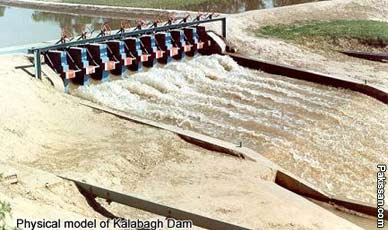|
Special
Reports/Water Crisis |
Kalabagh dam and political pressures
By Ahmad Fraz Khan
 THE
Kalabagh controversy refuses to go away, even in its
“abandoning”. As it appears, it would not get resolved in
future either and keep haunting the nation. THE
Kalabagh controversy refuses to go away, even in its
“abandoning”. As it appears, it would not get resolved in
future either and keep haunting the nation.
The successive governments’ strategy of avoiding water
sector development in order to ‘save the federation’ from
political pressures has not helped. Neither the controversy
nor the pressure can be wished away by taking arbitrary
decisions.
The manner in which the PPP government announced it intends
to abandon the Kalabagh dam would only add fuel to the fire.
Instead of taking up the project for democratic debate at
the national level and at the proper forum like the Council
of Common Interest, or the parliament to resolve it either
way, the government has simply “shelved it for good.”
In shelving the project, if the PPP government has taken cue
from persistent political controversies around the dam,
those in favour point finger to periods when the project had
national consensus behind it.
During the sixties when the Indus Basin Water Treaty was
signed, the Kalabagh dam emerged as the most favourite site.
President Ayub Khan dropped it in favour of Tarbella site,
which fell in his native area.
Then the consensus emerged in Water Accord of 1991, which
was signed by all four chief ministers, and clearly states:
“The need for storages, where ever feasible on the Indus and
other rivers was admitted and recognised by the participants
for planned future agriculture development.” The accord was
approved by the Council of Common Interests on March 21,
1991.
The previous government also formed technical and
parliamentary committees on the issue to evolve consensus.
The technical committee in its report supported the project
and the parliamentary committee did not oppose it either.
The PPP government’s choice to take only controversial side
of the project as a reference point would only worsen the
problem.
It seems to have forgotten that pressure on the federation
could only be removed by dealing with water paucity by
building dams. By delaying decisions, it could only generate
extra pressure on the federation.
In the heat of the moment, the government also ignored the
fact that the Kalabagh dam has been the most studied – it
was subjected to a series of most exhaustive studies
spanning three decades (1953-1982) – and it was a
technically sound project. If the three smaller provinces
somehow view it as a Punjab project, farmers in Punjab would
hold people from other federating units responsible for
abandoning it.
Abandoning the Kalabagh dam project, without coming up with
an alternative in a certain timeframe, is not only bad
politics but the worst economics.
It is not the site of a particular dam per say which makes
it favourite or otherwise, but bigger issues like economic,
power and agriculture needs define a project. No can deal
with these realities without building water reservoirs. Only
a credible institution like parliament should take such
decisions because it has to deal with these bigger issues.
At present, the country not only needs a particular dam but
a series of them because its agriculture, the economic base
of the country, is in bad shape.
Agriculture experts say if these water shortages are
removed, per acre yield of almost all major crops could
increase immediately and add Rs160 billion to the national
economy. Over 18 billion units of electricity, their cost
and impact are in addition to the loss the government
suffers because of lack of water storage. The per capita
water availability, which stood at 5,700 cubic meters in
1947, has dropped to 1,070, with 1,000 being the red line.
Pakistan used to have 15.9maf storage capacity, which has
now dropped down to 11.6maf – a loss of 27 per cent. It
simply translates into water shortages for agriculture.
During the current Kahrif season, the country suffered a
water shortage of 26 per cent and during the last Rabi it
was at 23 per cent. Tarbella Dam used to serve water needs
up to mid -June, when the refilling starts. It now hits dead
level by late-February or early March. Silt eats 10-day
irrigation supply every year forcing early emptying of lake.
All these statistics are part of official record and debate.
Until and unless, the government comes up with a viable
alternative plan to meet the water and power needs, it would
only be making water problems more complex.
The Indus Basin Water Treaty gives Punjab exclusive rights
over 9maf water storage to compensate it for loss of three
eastern rivers. That is why Mangla and Tarbella Dams were
built. No one seems to be bothered as to what would happen
when the total storage capacity dwindles to 9maf and Punjab
approaches the federation with exclusive rights over entire
storages, leaving other three federating units on the run of
river.
All these issues must be taken up in parliament and other
federal bodies like the Council of Common Interest and
debated and resolved in the federal spirit. Taking arbitrary
decision in favour of one project or against other, would
neither remove poverty nor pressure on the federation.
Courtesy :
The DAWN
|
Pakissan.com;
|